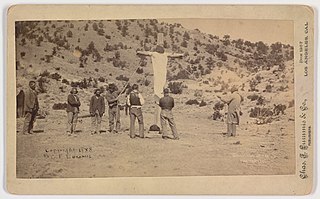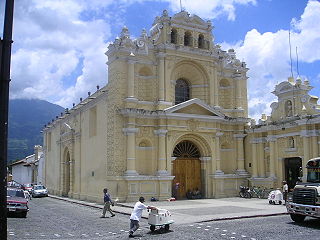
The Franciscans are a group of related mendicant religious orders of the Catholic Church. Founded in 1209 by the Italian saint Francis of Assisi, these orders include three independent orders for men, orders for nuns such as the Order of Saint Clare, and the Third Order of Saint Francis open to male and female members. They adhere to the teachings and spiritual disciplines of the founder and of his main associates and followers, such as Clare of Assisi, Anthony of Padua, and Elizabeth of Hungary. Several smaller Protestant Franciscan orders or other groups have been established since late 1800's as well, particularly in the Anglican and Lutheran traditions.

Antigua Guatemala, commonly known as Antigua or La Antigua, is a city in the central highlands of Guatemala. The city was the capital of the Captaincy General of Guatemala from 1543 through 1773, with much of its Baroque-influenced architecture and layout dating from that period. These characteristics had it designated as a UNESCO World Heritage Site in 1979. Antigua Guatemala serves as the capital of the homonymous municipality and the Sacatepéquez Department.

Camillus de Lellis, M.I., was a Roman Catholic priest from Italy who founded the Camillians, a religious order dedicated to the care of the sick. He was beatified by Pope Benedict XIV in the year 1742, and canonized by him four years later in 1746. De Lellis is the patron saint of the sick, hospitals, nurses and physicians. His assistance is also invoked against gambling.

Mendicant orders are, primarily, certain Roman Catholic religious orders that have adopted for their male members a lifestyle of poverty, traveling, and living in urban areas for purposes of preaching, evangelization, and ministry, especially to the poor. At their foundation these orders rejected the previously established monastic model. This model prescribed living in one stable, isolated community where members worked at a trade and owned property in common, including land, buildings and other wealth. By contrast, the mendicants avoided owning property at all, did not work at a trade, and embraced a poor, often itinerant lifestyle. They depended for their survival on the goodwill of the people to whom they preached. The members of these orders are not called monks but friars.
The Passionists, officially named the Congregation of the Passion of Jesus Christ, abbreviated CP, are a Catholic clerical religious congregation of pontifical right for men, founded by Paul of the Cross in 1720, with a special emphasis on and devotion to the Passion of Jesus Christ. A known symbol of the congregation is the labeled emblem of the Sacred Heart of Jesus, surmounted by a cross. This symbol is often sewn into the attire of its congregants.

Bethlehemites, or Bethlemites, is the name of five Catholic religious orders. Two of them were restored to existence in the 20th century. The other three are extinct.

Peter of Saint Joseph de Betancur y Gonzáles, OFB, also called Hermano Pedro de San José Betancurt or more simply Peter de Betancurt, Hermano Pedro, Santo Hermano Pedro, or San Pedro de Vilaflor, was a Spanish saint and missionary in Guatemala.

Los Hermanos de la Fraternidad Piadosa de Nuestro Padre Jesús Nazareno, also known as Los Penitentes, Los Hermanos, the Brotherhood of our Father Jesus of Nazareth and the Penitente Brotherhood, is a lay confraternity of Spanish-American Catholic men active in Northern and Central New Mexico and southern Colorado. They maintain religious meeting buildings, which are not formal churches, called moradas.

Payo Enríquez de Rivera y Manrique, O.E.S.A., was a Spanish Augustinian friar who served as the Bishop of Guatemala (1657–67), Archbishop of Mexico (1668–1681) and Viceroy of New Spain.
The Third Order of Saint Francis is a third order in the Franciscan tradition of Christianity, founded by the medieval Italian Catholic friar Francis of Assisi.

The Camillians or Clerics Regular, Ministers to the Sick are a Catholic religious order founded in 1582 by St. Camillus de Lellis (1550-1614). A large red cross was chosen by the founder as the distinguishing badge for the members of the Order to wear upon their black cassocks, which was later adopted as the international symbol of medical care. In the past, because of the red cross on their apparel, they were also referred to as the Crociferi. As of 2018, 1080 Camillians serve in 35 countries. They use the postnominal initials of M.I..

The Obregonians, or the Minim Congregation of Poor Brothers Infirmarians, were a small Roman Catholic congregation of men dedicated to the nursing care of the sick, who professed the Rule of the Third Order Regular of St. Francis.

Joaquina Vedruna de Mas - born Joaquima de Vedruna Vidal de Mas, religious name Joaquina of Saint Francis of Assisi - was a Spanish religious sister and the founder of the Carmelite Sisters of Charity. Her canonisation was celebrated on 12 April 1959.

San Pedro is a hospital and adjacent church in Antigua Guatemala, Guatemala. It is dedicated to Peter of Saint Joseph Betancur.
A religious brother is a member of a religious institute or religious order who commits himself to following Christ in consecrated life of the Church, usually by the vows of poverty, chastity and obedience. He is usually a layman and usually lives in a religious community and works in a ministry appropriate to his capabilities.
San Hipólito Hospital is a general medical facility in Mexico City that began as the first psychiatric facility in the Americas. It was founded by Brother Bernardino Álvarez in 1569. It was supported by the first religious order in Mexico called San Hipolito Order of Charity. The money used to maintain the hospital came from alms that Christians collected on the streets. The people who worked on San Hipólito Hospital were prisoners, captured pirates and slaves, which included the indigenous. The hospital's building has changed its purpose several times. It started as a psychiatric hospital that then changed into a military base, which three years later was used again as a hospital. In 1905, the building was partially destroyed. When it was rebuilt, it became a shelter for poor people. At the end of 1970, the facilities were once again a hospital but this time as a general medical center.

The Sanctuary of the Santo Hermano Pedro is a pilgrimage temple located in the town of Vilaflor, south of the island of Tenerife. The shrine is dedicated to Saint Peter of Saint Joseph Betancur, the first Saint of the Canary Islands.
The Comboni Missionary Sisters are a Catholic religious institute originally founded under the name Pie Madri della Nigrizia, translated as the "Pious Mothers of the Nigritia" or "The Devout Mothers of Africa". They are also known as the Missionary Sisters Pie Madre della Nigrizia or the Missionary Sisters of Verona,














